The Orchidaceae family is the largest family of flowering plants, with up to 880 genera and over 26,000 recognized species. Several hundred of them are unusual and rare orchid flowers species, many of which are on the verge of extinction.
These plants have an extravagant appearance and color, some of them are ubiquitous in nature, others are endemic.
Among the rare orchids, the most beautiful are those with a unique flower shape. There are also varieties with the rare color of petals.
21 Rare Orchid Flowers Plant
Ballerina orchid
The endemic Caladenia melanema in its natural environment grows in one place in the Southwest of the Australian continent near Lake Altam. Unlike most varieties of the plant “Ballerina” grows in the sand near the salt water of the lake, and not on trees. By 2006, there were only three hundred mature plants from two populations.
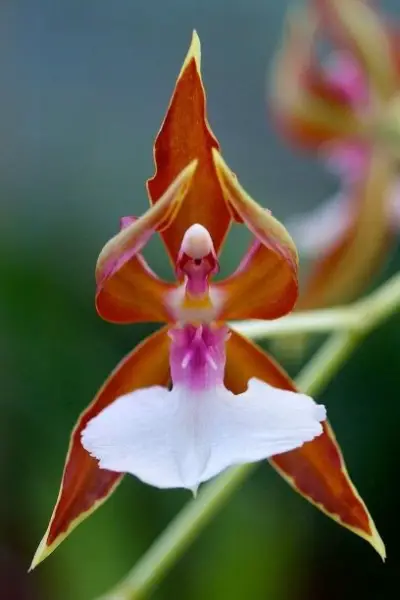
The main feature of the flower is its shape, which in appearance resembles a dancing ballerina on pointe shoes with her arms gracefully raised up.
Other distinctive features of the species include the following:
- flower diameter – 4–5 cm;
- stem height – up to 15 cm;
- the shade of the inflorescence (in rare cases there are two, and not one) – pale yellow or cream with reddish tints along the edges;
- has a single pubescent leaf.
Dracula or monkey face orchid
Dracula simia is one of the rarest orchid species native to the tropical rainforests of Central and South America. It is most often found in Ecuador and Peru at an altitude of about two thousand meters above sea level.

The main distinguishing feature of the plant is the unique arrangement of petals, folding into a pattern that resembles the muzzle of a pensive or sad monkey. The flower also has a rich bouquet of aromas: from bright citrus, similar to the smell of ripe oranges, to unpleasant, reminiscent of rotten meat. Read out full guide on Monkey Face Orchid (Dracula Chimaera).
About 20 of its varieties are included in the Red Book.
Other features of the plant include:
- growing only under low temperature conditions;
- year-round flowering, but in some varieties it lasts only a few hours, while the flowers open sequentially;
- variety of colors – from snow-white to dark brown;
- the presence of several flowers on the inflorescence.
Carrot or catasetum orchid and caring for it
This type of orchid has the Latin name Catasetum and belongs to the group Catasetinae, affectionately referred to as “carrots.” There are about 150 species in total. These unusual flowers grow in most regions of Central and South America, especially many varieties can be found in Brazil.

The catasetum orchid has intricate flowers. Due to the pseudobulbs and long hard leaves, the plant looks very beautiful even when there are no buds on it.
This orchid is characterized by pronounced sexual dimorphism, in which male flowers reach 10–12 cm in diameter, while female flowers do not look so large and beautiful.
Carrot care depends on the growth period. During the growing season, usually in early spring, when new pseudobulbs appear in the orchid, the plant is actively watered and fertilized. In this case, after 3-4 months, new flower stalks appear on the flower. By the end of autumn, during the dormant period, the foliage begins to fade and turn yellow. Watering is reduced by half, and feeding is stopped. It is also necessary to reduce the temperature of the content. In winter, watering the catasetum may not be carried out at all.
Ghost orchid
Ghost Orchid, or Dendrophylax lindenii, was recently considered an extinct species. The plant grows in shaded forests in Cuba, the Bahamas, in some US states, such as Florida. Also eleven times the flower was seen in the swampy area of Britain.
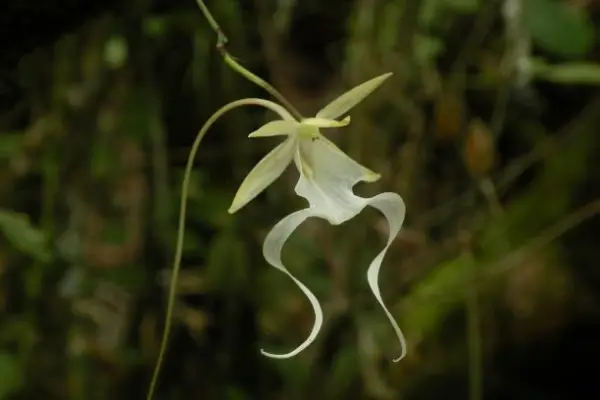
It grows on tree tops, has no leaves, but has bright white flowers that resemble ghosts or frog legs. The height is small – only 15 cm.
The root system of the plant has a photosynthetic effect. The roots merge with the flowering arrows, so it seems that flowers appear in the air, as if from emptiness.
Check out Bulbophyllum Orchid Plants.
Sleeping baby orchid
Orchid “Baby in diapers” or “Sleeping baby” is also called Anguloa or Anguloa Uniflora. It is a terrestrial plant from South America that grows in Colombia, Bolivia, Ecuador, Venezuela and Peru at an altitude of one and a half to two and a half thousand meters above sea level. The main habitat is shaded and cool areas of humid mountain forests.
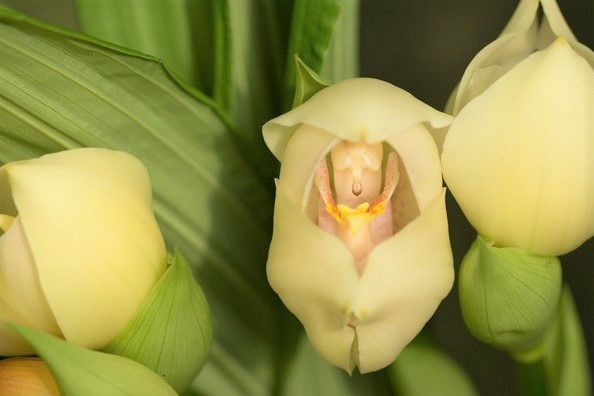
A distinctive feature of the plant is the unique shape of the flower, which at the moment of autumn flowering resembles a sleeping baby wrapped in an envelope with a pacifier in its mouth. The color of the flowers is light with a pinkish tint in the central part, the aroma is pleasant.
Flying duck orchid
Caleana major is a small plant (up to half a meter), leading a terrestrial lifestyle and growing in Southeast Australia. Outwardly, it would be difficult to distinguish it from ordinary grass, if not for a bizarre flower in the form of a flying duck with a noticeable long beak.
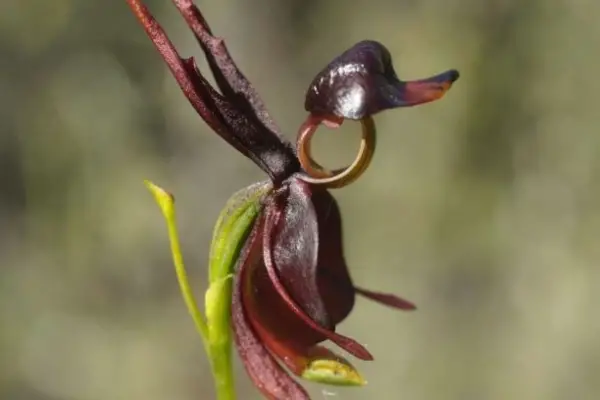
The plant survives only in the wild; indoors it quickly weakens and dies off.
Other features of the orchid include:
- the number of flowers on the stem is from 2 to 4;
- has a single narrow-lanceolate leaf located near the base of the stem;
- coloring – purple, brown or red-brown, in rare cases greenish with dark markings on the petals;
- flowering period – from September to January.
Happy alien orchid
Calceolaria Uniflora is a long-liver among plants from the Calceolaria family, capable of living up to a hundred years. Inhabits the highlands of South America.
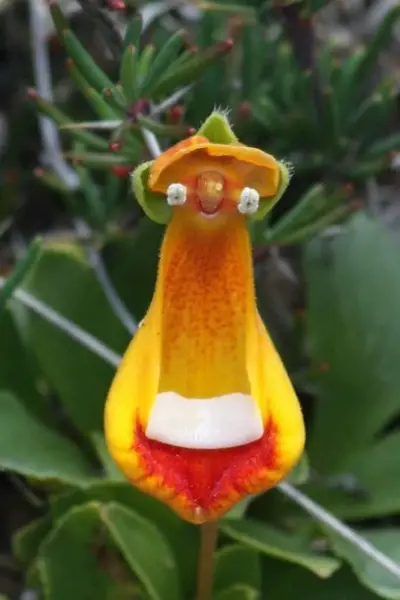
In shape, the flowers in the shape of a “hoof” or “purse” resemble a smiling alien with small eyes. The color is bright orange with reddish dots that attract insects and a white nectar disc at the bottom. Other features of the plant:
- light aroma;
- height – up to 20 cm;
- flowers after cutting do not wither for several weeks;
- blooms at home for up to six months.
Dove or peristeria high orchid
Peristeria elata belongs to the sympodial epiphytes. Homeland of the plant – Central America, Ecuador and Venezuela, it is also considered an endangered species and the national symbol of Panama.

The middle part of the beautiful flower has a unique shape, reminiscent of a dove sitting in a nest. Other characteristic features of the orchid:
- height – up to 1 m;
- the number of flowers is from 4 to 12;
- color – marble-white with purple ornament;
- the aroma is similar to the smell of beer;
- flowering period – from July to October.
Dancing girls orchid
Impatiens Bequaertii is a collectible herbaceous perennial from the balsam family and does not belong to orchids.
But it has an unusual shape, which is why it is on the list of the rarest flowers.
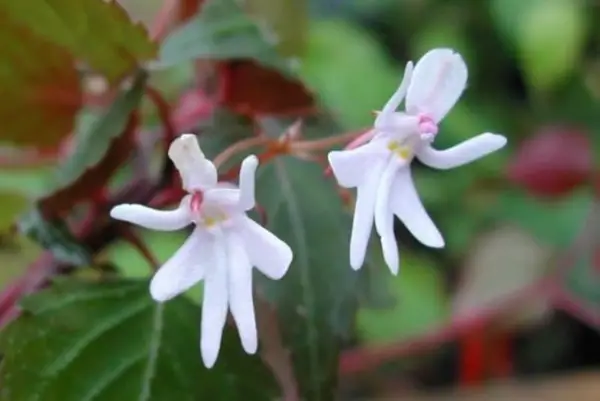
Originally from the tropical forests of East Africa. The flowers look like dancing girls in skirts with outstretched arms. Other features of the plant include the following:
- compact size: stems – up to 30 cm in height, flowers diameter – 1–2 cm;
- white or light pink color of the petals.
White heron orchid
Habenaria radiata belongs to medium-sized tuberous geophytes. The plant is found in Japan, China, Korea, Russia, and is included in the Red Book of Primorsky Krai.

In shape, the flowers resemble a snow-white heron soaring up. Other salient features:
- height – up to half a meter;
- flower diameter – 3–6 cm;
- the number of inflorescences – 3-4;
- number of leaves – up to 8 pcs.
Laughing bumblebee orchid
Ophrys Bombyliflora is a native of the Mediterranean. It grows in Turkey and Lebanon, Portugal and the Canary Islands.
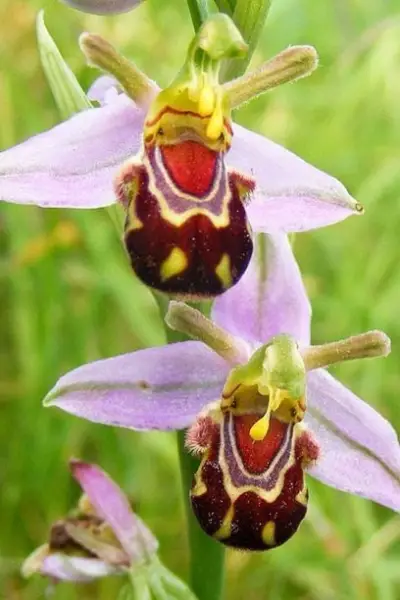
The flowers are shaped like a smiling bumblebee with brown-red or purple-spotted colors. They mimic the smell of a female, prompting male bumblebees to pollinate them. The height of the plant does not exceed 20 cm, the number of flowers with green sepals, formed in the period from February to May, is from 2 to 5 pcs.
Naked Man (Italian Orchis)
Orchis italica is a rare perennial that grows in the Mediterranean, Sardinia, Portugal, Spain, Morocco and Lebanon. The Italian name of the plant is Naked man Orchid, it was in Italy that the flower was taken under protection.
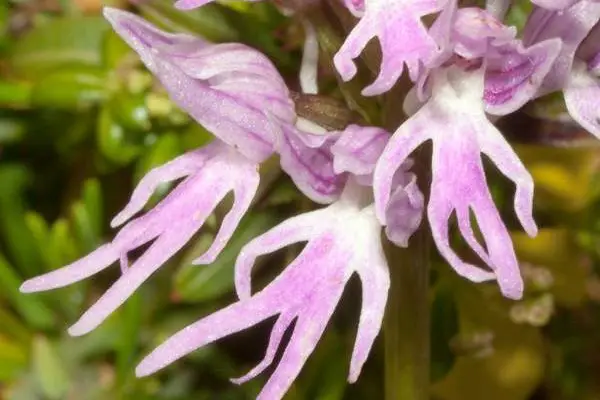
The flower got its special name because of the shape of the lamellum of each flower, which resembles a naked man in appearance. The rest of the features of the plant include:
- height – up to 50 cm;
- the color of the petals is hot pink;
- flowers – tightly grouped;
- the aroma is pleasant, but rather harsh.
read out What is Miltoniopsis Orchids.
Hot lips orchid
Psychotria elata is a tropical undersized native to the forests of Central and South America from the Myrene family. Another name is Hooper’s Lips.
Until the flower fully unfolds, the shape resembles bright red lips, ready for a kiss. Presumably, the plant attracts pollinators – hummingbirds and butterflies through its unusual appearance.
Angel orchid

The orchid Habenaria Grandifloriformis is distributed throughout the world with the exception of Antarctica. In total, there are about 800 species of this plant, some of which can be found in the Far East in Russia, where they are called “Povodnik ray”.
In shape, the flower resembles an angel with spread wings behind its back. The color of the petals is snow-white.
Bearded orchid
The undersized plant Calochilus robertsonii is native to the Green Continent and New Zealand. This orchid can be found in dry forest areas.
Lamellum is covered with purple hairs with an admixture of brown, reminiscent of a long beard. The flowers are small (the diameter does not exceed 2 cm), the number is from 2 to 10, the stem is fleshy, erect, the flowering period is from September to January.
Fly orchid
Ophrys insectifera belongs to the genus Ophrys. It grows on the alkaline soils of Europe.
In shape and dark shade, the flowers are similar to a fly, but the main pollinators are wasps, hornets, bumblebees and bees. The smell of an orchid is quite pungent and mimics the pheromones of a female insect. Bloom in June.
Platistele orchid
Platystele ovatilabia was recently discovered. It was discovered by Professor Jost in the Cerro Candelaria Nature Reserve, located in the eastern Andes in Ecuador.
Today, the flower is considered the smallest in the world. The length of its absolutely transparent petals does not exceed 2 mm.
Lady’s slipper orchid
This species includes several genera of orchids, which are united by the shape of the plant, similar to a shoe or slipper.
Cypripedium calceolus belongs to the orchid family. The plant is distributed throughout the European and Asian continent, grows in the USA and Canada. The flowers are colored bright yellow. The configuration is bowl-shaped, reminiscent of a miniature shoe.
Paphiopedilum or paphiopedilum has won the attention of flower growers in many countries due to its hybrid varieties, which are unpretentious in care, unlike their natural counterparts. The most popular indoor varieties are Gratrixianum and Bellatum.
odontoglossum orchid
Odontoglossum is a herbaceous perennial. Grows in open areas in moist forests. Prefers high ground.
The plant can be found in Central and Western South America, Guyana. In shape, the flower resembles a tongue with two teeth-like outgrowths at the base of the lip of the flower corolla. Colors: from snow-white to bright yellow and green-brown.
With unusual leaves
In addition to the unique shape of the flowers, orchids can also have special leaf plates.
Ludisia orchid
Ludisia discolor grows in Asia (China, Thailand, Vietnam, the Philippines, etc.) in wooded areas. Possesses an ordinary appearance.
It is appreciated by flower growers only due to the leaves with a velvety surface, decorated with red veins. The flowers are of no decorative value, they are too small and pale.
macodes orchid
Macodes is a geophyte found in Southeast Asia, New Guinea, the Solomon, and Ryukyu Islands.
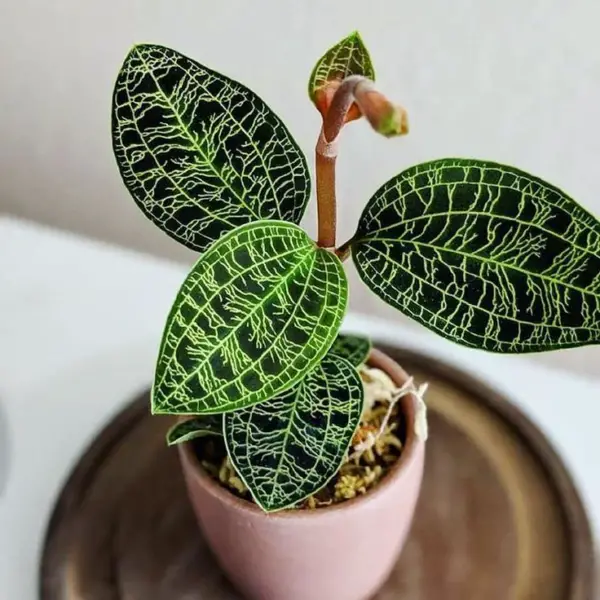
The plant is distinguished by large dark green leaf plates decorated with light green veins. You can see a bizarre pattern on each sheet.
Here is out guide Orchid Seed Germination.
which rare orchid flower you can grow at home?
Not all types of rare orchids can be grown at home. As a rule, most of them can live in the closed ground for no more than a year, while in natural conditions the life expectancy of plants is 10 years or more.
The most suitable for indoor breeding are:
- orchids Catasetum or “carrots”, which does not require complex care;
- odontoglossum is increasingly appearing on windowsills, popular varieties for home growing: Bikton, Crispum and pretty;
- dancing girls, taking root in a small container while creating as close to natural conditions as possible;
- hybrid varieties of papiopedilum Venus slipper perfectly adapt to home conditions;
- egret cultivated as a garden and indoor flower;
- naked man, unpretentious and for this reason often grown at home;
- potted ludisia and makodes thanks to its beautiful leaves.
The orchid family is full of unique plants with unusual colors and shapes of flowers and leaves. Many of these rare species are on the verge of extinction and are listed in the Red Book.
